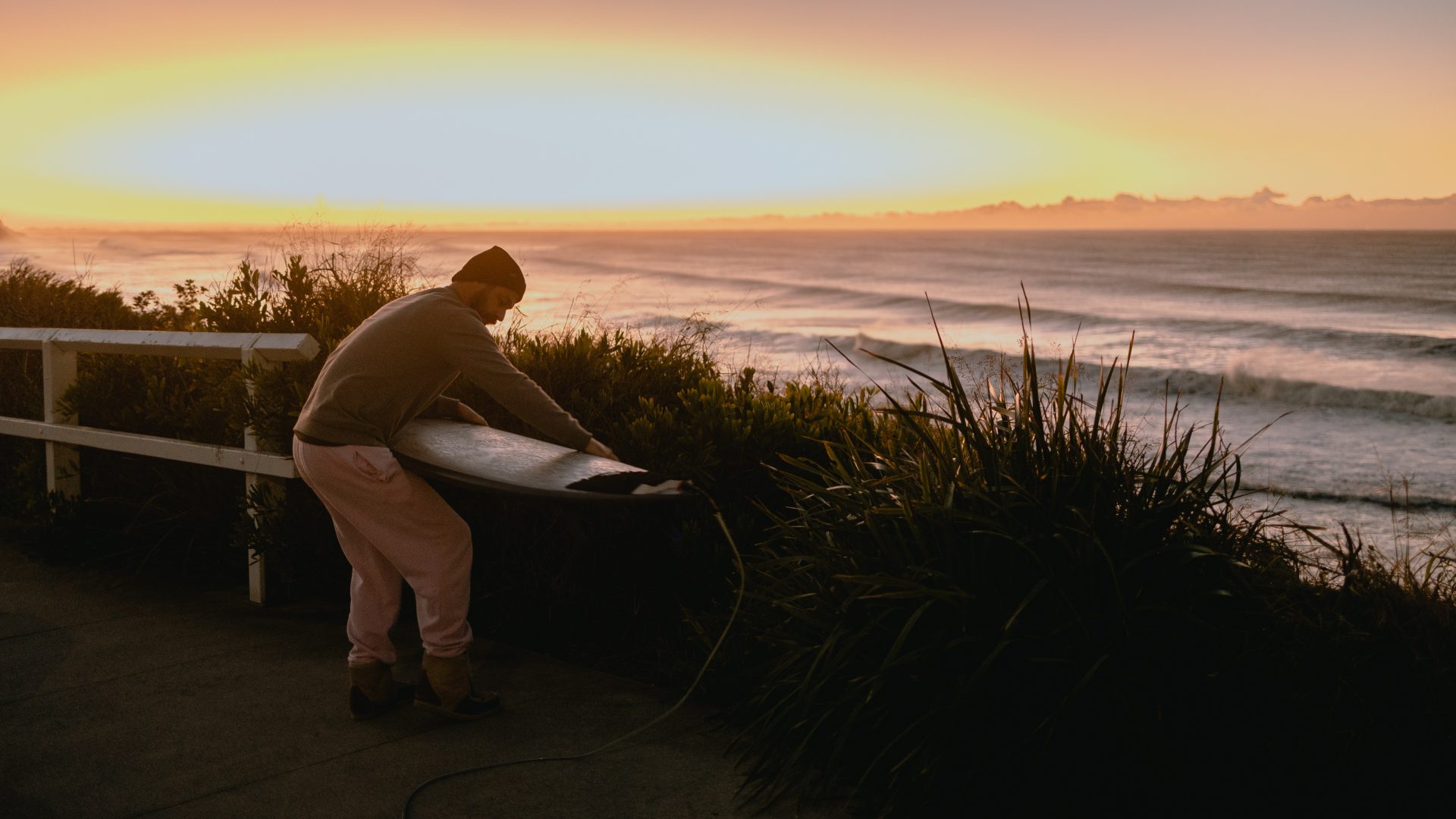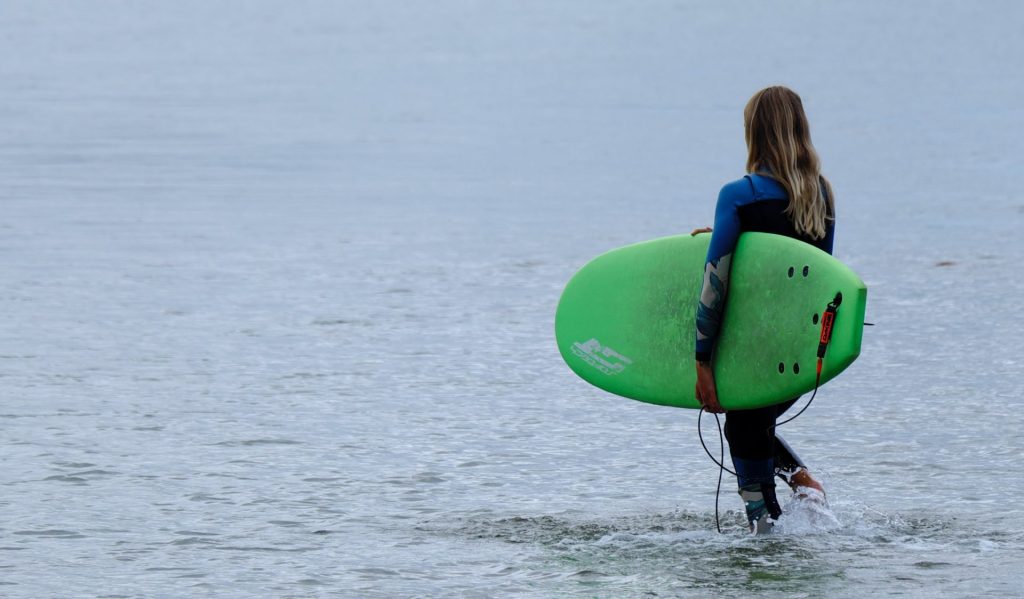How To Wax A Surfboard In 8 Steps [With Video]

Knowing how to wax a surfboard is an essential step when stepping into to the surfing world.
Knowing how to wax a surfboard correctly ensures that your feet will stay firmly planted on the board, allowing for responsive manoeuvres whilst preventing slips.
No matter what surf wax you apply to your surfboard, this guide will ensure you can wax up confidently each time you surf.
How To Wax a Surfboard
Supplies To Wax a Surfboard
- Wax Comb: To create or maintain the wax bumps or patterns on your surfboard for better traction.
- Base Coat Wax (optional): Provides an even base layer, enhancing the performance of topcoat wax.
- Surf Wax: To add wax to your surfboard so it will be grippy next time you surf.
- Proper surface (clean and dry surfboard): Ensures that the surfboard is ready for wax application.
- Wax container or storage solution (if not in use): To keep your wax clean and fresh between sessions.
How To Wax a Surfboard Video
Steps Guiding You How To Wax a Surfboard
1. Get Surf Wax Remover
Begin by gathering your materials, including surf wax remover, a wax comb or scraper, a clean cloth or paper towels, and your chosen surf wax.
2. Remove Old Wax
Find a well-ventilated space to work, and use the wax comb or scraper to gently but thoroughly remove all old wax from your surfboard. Start at one edge and work your way across the entire deck.
Here is a helpful video showing you in detail how to remove wax from your board:
3. Clean Surfboard
After wax removal, clean the board using a surf wax remover or mild soap and water to eliminate any remaining wax residue. Rinse the board thoroughly and let it air dry completely.
4. Select Surf Wax
Choose an appropriate surf wax based on the water temperature and the type of waves you'll be surfing. Wax comes in various formulas designed for warm, cool, or tropical waters.
5. Apply Base Coat Wax
Hold your base coat wax sideways and rub it firmly over the entire deck of the board, using a crisscross pattern. Apply even pressure to create a textured base coat, ensuring coverage where your chest and feet will be positioned.
6. Apply Top Coat Wax
After the base coat, use the same or a different wax bar to apply a top coat. This time, use long, diagonal strokes to create a wax layer with enhanced grip. Concentrate the top coat where your hands will rest for stability and control.
7. Test The Wax
Before heading into the water, run your fingers over the waxed areas to check the texture. It should feel slightly rough and grippy. If it feels too smooth, apply additional top coat wax in areas where you need more traction.
8. Re-apply Wax If Necessary
Over time, the wax will wear down. Before each surf session, inspect your board. If the wax is worn or too smooth, touch up the top coat as needed to maintain the proper grip and traction.
How Long Does It Take To Wax A Surfboard?
Waxing a surfboard typically takes around 15-20 minutes, but it can vary depending on your experience and the condition of the board. It's a straightforward process that becomes quicker with practice.
Should You Wax a Surfboard Before Every Surf?
Yes, you should wax your surfboard before every session. Wax provides the necessary grip and traction for safe and enjoyable surfing. Regularly checking and reapplying wax ensures you maintain a secure footing on the board.
Ensure you store surf wax in the correct place to keep it ready for your next surf session!
Do You Wax The Whole Surfboard?
No, you don't need to wax the entire board. Focus on waxing the areas where your body comes into contact with the board, such as the deck where you lay or stand. This includes the chest area and areas for your hands and feet to provide grip and control.
Wax the key areas of your surfboard's deck, starting with the chest area and extending toward the tail where your feet will be positioned. Additionally, apply wax where you'll place your hands for paddling and stability. Avoid waxing the nose of the board to prevent wax smudging onto your wetsuit.

Should You Wax A Foam Surfboard?
Yes, you should wax a foam surfboard just like you would wax a fiberglass board. Waxing provides grip and traction, which is important for stability and control while riding waves, regardless of the type of surfboard you're using. Foam boards are no exception, and waxing them is essential for a safe and enjoyable surfing experience.
How To Wax A Surfboard For Cold Water
For cold water conditions, choose a cold-water-specific surf wax. Cold water wax is harder and provides better grip in cooler temperatures. Apply it in the same manner as regular wax, focusing on the essential areas of the board.
Do You Need Base Coat Wax For A Surfboard?
Yes, a base coat is important as it provides the initial texture for grip. It prepares the surface for the top coat, which enhances traction. Applying both base coat and top coat wax ensures a secure footing on your board.
How to Wax a Surfboard with a Base Coat
Waxing a surfboard with a base coat is essential for a good grip on your board. Start by cleaning your board to remove any old wax or dirt. Once it's clean, apply a base coat by rubbing the wax firmly in a crisscross pattern to create a solid foundation. This helps your topcoat wax stick better and provides an even grip.
How to Wax a Surfboard for the First Time
If you're waxing your surfboard for the first time, don't worry; it's not as tricky as it may seem. Begin by cleaning your board, ensuring there's no residue or dirt. Then, apply a base coat. Once the base coat is in place, apply your topcoat wax.
Make sure to evenly distribute it and use a wax comb to create grooves for better traction. You need to know what temperature surf wax to apply to your board so always check this!
How to Wax a Surfboard That is Mid-Length?
Waxing a mid-length surfboard follows a similar process to waxing other boards. Clean the board thoroughly and apply a base coat. When it comes to the topcoat wax, consider the length and design of your mid-length board. Focus on creating a grip that suits your riding style, whether it's for cruising or more aggressive maneuvers.
Waxing a Surfboard for Specific Conditions
Different surf conditions call for specific waxing techniques.
In cold water, you'll want a softer wax for better traction. In warm water, a harder wax is ideal. For big waves, use a tropical wax, and for smaller, slower waves, a softer wax helps. Always adapt your wax to the conditions you'll be surfing in.
Surfboard Wax Patterns
Surfboard wax patterns aren't just for aesthetics; they serve a functional purpose.
Whether it's the classic crosshatch or circular patterns, the goal is to create grooves that provide traction. Experiment with different patterns to find what works best for you and your surfing style. See here for how to to the cross hatch styled wax.
How To Wax A Surfboard With Unique Patterns
Summing It Up: What To Do Now
Now you know how to wax a surfboard, it's time to get in the surf!
If your interested in learning more about surfing discover our many guides that will inform you on your surfing journey. Don't forget to follow us on Facebook & Instagram to stay informed on our amazing surf shots and stories shared from surf creators around the world!
Frequently Asked Questions
What is the best way to wax a surfboard?
The best way to wax a surfboard involves applying a base coat of surfboard wax, then adding a topcoat of wax in a crosshatch or circular pattern. The exact method can vary depending on personal preference, but ensuring a good balance between grip and ease of movement is key.
How often do I wax a surfboard?
The frequency of waxing your surfboard depends on various factors such as water temperature, the type of wax used, and how often you surf. In general, you may need to reapply wax every few surf sessions, potentially weekly or even daily if you're a frequent surfer.
Do I need to wax my new surfboard?
Yes, even new surfboards need waxing. Most new surfboards come without wax, and applying a base coat of wax is essential for providing grip and control while you surf. You can adjust the wax application as needed based on your preferences and surf conditions.
How long does it take to dewax a surfboard? surf wax go bad?
The time it takes to dewax a surfboard can vary, but it typically takes around 15 to 30 minutes to remove old wax. You can use a wax comb, wax remover, or a heat gun to make the process more efficient.
How much of my surfboard do I wax?
You should wax the deck of your surfboard, which is the top surface where you stand. Apply wax in the areas where your feet will be positioned to ensure a good grip. Some surfers prefer to wax a wider area for better control and manoeuvrability.
What is the first coat of wax on a surfboard?
The first coat of wax on a surfboard is typically the base coat. You should evenly apply a thin layer of base coat wax to the entire deck of your surfboard. This layer provides a foundation for the topcoat, which you can customise for your desired level of grip.


